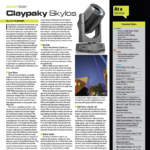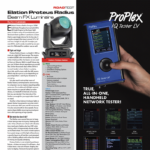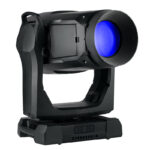There is a saying that big things come in small packages. Measuring in at a whisper over 12 inches long and 4 inches wide, the new HD video switcher from Roland is proof of that. This sophisticated-yet-compact video switcher combines professional compositing features such as keying, graphic inserts, titling and numerous visual effects with the ability to connect to a variety of HDMI sources, smart phones and video cameras…even a 12 channel audio mixer. Safe to say, this switcher can manage a lot.
What It Is
The primary function of the V-1HD is as an HD video switcher. The switcher’s four HDMI inputs and two HDMI outputs support resolutions up to 1080p, at either 59.94 or 50 Hz, and sources for the switcher can be practically any HDMI device including Blu-Ray players, tablets, and computers. Switching between sources is achieved either via “Transformer” buttons or the T-Fader, and each bus has its own control for Visual Effects.
Who It’s For
Based on its size, the Roland V-1HD HD is a very portable video switcher that would be ideal for on-site broadcasts, conference rooms, educational applications and video switching in trade show booths — practically anywhere a small-yet-practical solution for video switching is needed. I also feel that this video switcher has a place in the lighting/media server control world, especially given its size, feature set and ability to be controlled via MIDI. For instance, if combined with a media server that did not have internal single-layer transition features like wipes, dissolves, etc., the V-1HD could eliminate those types of programming challenges easily. Programmers of media servers with two outputs could set up their cues between layers and let the V-1HD do the work of transitioning.
Feature Highlights
The V-1HD is packed with many great features including:
- Multiple types of transitions including Cut, Mixes, and Wipes with a variable timing control
- Multiple compositing effects including Picture-in-Picture, Split, Chroma/Luminance Key and nine filter effects including Silhouette, FindEdge and Negative
- A freeze function to momentarily pause incoming video
- An output fade function that allows you to crossfade an output to black or white
- A 12 channel audio mixer console with audio inputs and outputs
- A BPM tap-to-sync function that can be used to sync visuals to audio
Pros: Portable, Powerful, Affordable
The V-1HD is many things, all of them really good! It’s portable, powerful and affordable and is very easy to setup and use. All of its four inputs and two outputs support resolutions up to 1080p. I also like that it can connect to practically anything, making the integration of tablets, computers, and apps on smart phones into your show simple. And it makes connecting to a Blu-ray player or other copyright protected content source easy as well with its HDCP support.
The V-1HD uses progressive processing, so interlaced input sources are automatically converted to a progressive signal. The conversion methods provided, Bob and Weave, are assigned in the Setup menu.
A nice feature of the switcher for me as a lighting programmer is the remote MIDI control option. Using MIDI, I can control everything the switcher does remotely from a lighting console, provided I take the time to set up the MIDI strings necessary in my lighting cues. Again, not something every show needs, but there are times when you have to use external video sources like cameras in addition to a media server that that lacks any sort of video input functionality, and being able to integrate transitions between these cues into your lighting cuelist via MIDI would work well.
Roland also offers a remote control software application for the V-1HD called the V-1HD RCS, and it is available for Mac, PC and iPad. Yes, that’s right, there’s an iPad app! I love my iPad, so having a touchscreen surface that interacts with the actual hardware and can do everything the hardware does means I can use it as a secondary controller for the Audio Mixer when the hardware is being used as the video switcher, or vice versa. And the RCS application for Mac or PC also allows you to backup your show data and settings, and perform system software up-dates too.
The Roland website, http://proav.roland.com, is also a great resource for all of their products. Easy to read, thorough, and not overly wordy technical support documentation on all fea-tures of the V-1HD was easy to find and access. Manufacturer’s documentation for their products is often the first point of contact for end users, so well-thought-out manuals and user guides are important.
Cons: HDMI-Only, Menu Navigation
As a lighting programmer who works with Media Servers in the land of DVI most of the time, HDMI connections mean that I’ll frequently need adapters to bridge the gap. But that’s not a huge problem, just something to check when specifying the gear on a show and planning how it all connects together. It’s also important to check to make sure that the type of display device you’re using can support the resolution of the V-1HD or at least it is set to the correct resolution before connecting. I mistakenly connected an output of the controller to a monitor in my office that had a maximum resolution of 1280×1024 (while the V-1HD was set to 1080p) and got nothing on the screen but black.
One thing that had me scratching my head for a bit: the menus for settings on the device. Since I spend a lot of time behind lighting consoles, I have grown accustomed to not searching in menus for the features I want to use. On the V-1HD, however, I stumbled through its menus because each of the three main levels for Setup, Memory and Audio has submenus. That made finding some settings challenging for me. I kept thinking, “I want to assign this to a Macro.” Luckily, there are eight internal memory storage buttons just for storing Memory and Au-dio settings as well as the operating state of the front panel (like a snapshot). While navigating these menus is easy enough using the hardware controls, I felt like I wanted more buttons to store things on. But then, the tradeoff might be a larger box, which I don’t want either. Okay, so maybe I am a little indecisive. But I really like this switcher, so I chose to adapt and embrace. Besides, accessing most of these settings is really only necessary during setup time anyway.
At a Glance:
Compact and Powerful
The V-1HD HD Video Switcher is an impressive video switcher in a small, portable package. Multiple HD inputs and outputs, compositing visual effects, transition effects, remote USB and MIDI control, 12 channel Audio Mixer and a T-Fader make this an affordable must-have for most AV companies, educational facilities, convention services, and would work equally as well in trade show booths where space is tight, concerts where cameras and media servers are used, and remote broadcast setups in the field. For all of these reasons, and many more, I give the V-1HD two thumbs up! —V.C.
Roland V-1HD Switcher
PROS:
- Portable, powerful and affordable
- Easy to setup and use
- Inputs (4) and outputs (2) support 1080p
- Connects to practically anything
- Interlaced input sources auto-convert to a progressive signal
- Remote MIDI option allows control via lighting console
- V-1HD RCS app for Mac and PC devices
- Website documentation easy to read
CONS:
- Need adapters to bridge gap between HDMI and DVI
- Be sure to check V-1HD and display device compatibility
- Menu and submenus for settings could be easier to navigate
STATS
Size: 12.33” x 4” x 2.33”
Weight: 2.65 lbs.
MSRP: $995
Manufacturer: Roland Pro A/V
More Info: http://proav.roland.com



